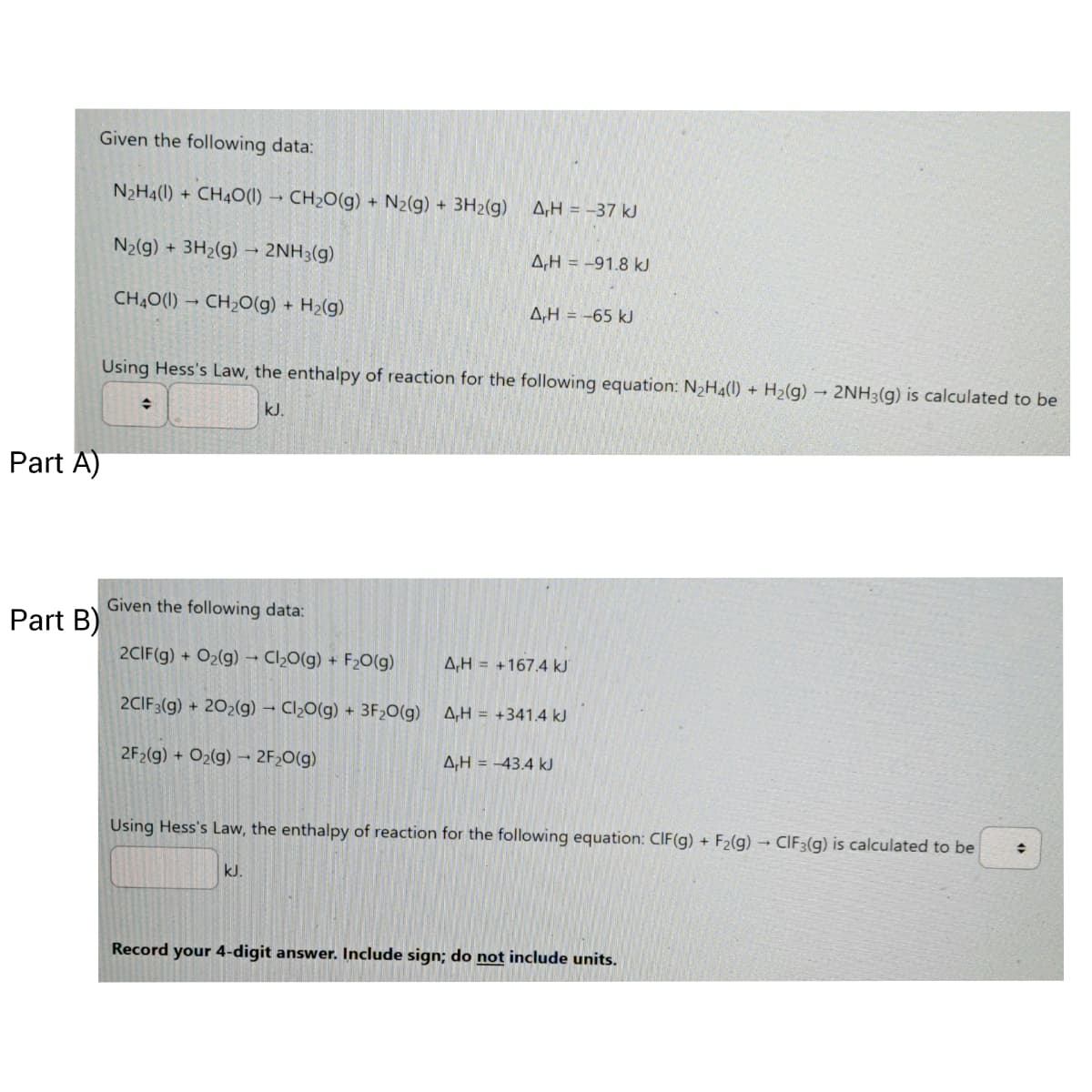Given the following data: N2H4(1) + CH4O(1) CH2O(g) + N2(g) + 3H2(g) Part A) N2(g) + 3H2(g) → 2NH3(g) AH = -37 kJ AH -91.8 kJ A,H=-65 kJ CH4O(1) CH2O(g) + H2(g) -> Using Hess's Law, the enthalpy of reaction for the following equation: N2H4(1) + H2(g) → 2NH3(g) is calculated to be kJ. Given the following data: Part B) 2CIF(g) + O2(g) → Cl₂O(g) + F2O(g) AH +167.4 kJ 2CIF3(g) + 202(g) - Cl₂O(g) + 3F2O(g) AH +341.4 kJ A,H = -43.4 kJ 2F2(g) + O2(g) 2F₂O(g) Using Hess's Law, the enthalpy of reaction for the following equation: CIF(g) + F2(g) → CIF3(g) is calculated to be kJ. Record your 4-digit answer. Include sign; do not include units.
Given the following data: N2H4(1) + CH4O(1) CH2O(g) + N2(g) + 3H2(g) Part A) N2(g) + 3H2(g) → 2NH3(g) AH = -37 kJ AH -91.8 kJ A,H=-65 kJ CH4O(1) CH2O(g) + H2(g) -> Using Hess's Law, the enthalpy of reaction for the following equation: N2H4(1) + H2(g) → 2NH3(g) is calculated to be kJ. Given the following data: Part B) 2CIF(g) + O2(g) → Cl₂O(g) + F2O(g) AH +167.4 kJ 2CIF3(g) + 202(g) - Cl₂O(g) + 3F2O(g) AH +341.4 kJ A,H = -43.4 kJ 2F2(g) + O2(g) 2F₂O(g) Using Hess's Law, the enthalpy of reaction for the following equation: CIF(g) + F2(g) → CIF3(g) is calculated to be kJ. Record your 4-digit answer. Include sign; do not include units.
Introduction to General, Organic and Biochemistry
11th Edition
ISBN:9781285869759
Author:Frederick A. Bettelheim, William H. Brown, Mary K. Campbell, Shawn O. Farrell, Omar Torres
Publisher:Frederick A. Bettelheim, William H. Brown, Mary K. Campbell, Shawn O. Farrell, Omar Torres
Chapter1: Matter, Energy, And Measurement
Section: Chapter Questions
Problem 1.86P: 1-86 The specific heats of some elements at 25oC are as follows: aluminum = 0.215 cal/g · oC; carbon...
Related questions
Question
Hi there! This is one question I have attached here. I know this may seem long but they really are in parts since the second part is related to part A) given I promise. From my side I had to take separate pictures of the parts because the parts are long as it won't let me take a full picture. Can you please please help answer the part A) and part B) for me please since I've been struggling to answer this question for days. Thank you so much. :)

Transcribed Image Text:Given the following data:
N2H4(1) + CH4O(1)CH2O(g) + N2(g) + 3H2(g)
N2(g) + 3H2(g) → 2NH3(g)
T
CH4O(1) CH2O(g) + H2(g)
AH = -37 kJ
A,H=-91.8 kJ
A,H=-65 kJ
Using Hess's Law, the enthalpy of reaction for the following equation: N₂H4(1) + H2(g) 2NH3(g) is calculated to be
kJ.
Part A)
Given the following data:
Part B)
T
2CIF(g) + O2(g) → Cl₂O(g) + F2O(g)
A,H+167.4 kJ
A,H+341.4 kJ
A,H = -43.4 kJ
2CIF3(g) + 202(g) → Cl₂O(g) + 3F₂O(g)
2F2(g) + O2(g) - 2F₂O(g)
Using Hess's Law, the enthalpy of reaction for the following equation: CIF(g) + F2(g) → CIF3(g) is calculated to be
KJ.
Record your 4-digit answer. Include sign; do not include units.
Expert Solution
This question has been solved!
Explore an expertly crafted, step-by-step solution for a thorough understanding of key concepts.
Step by step
Solved in 4 steps with 4 images

Knowledge Booster
Learn more about
Need a deep-dive on the concept behind this application? Look no further. Learn more about this topic, chemistry and related others by exploring similar questions and additional content below.Recommended textbooks for you

Introduction to General, Organic and Biochemistry
Chemistry
ISBN:
9781285869759
Author:
Frederick A. Bettelheim, William H. Brown, Mary K. Campbell, Shawn O. Farrell, Omar Torres
Publisher:
Cengage Learning

Introductory Chemistry: An Active Learning Approa…
Chemistry
ISBN:
9781305079250
Author:
Mark S. Cracolice, Ed Peters
Publisher:
Cengage Learning

Introduction to General, Organic and Biochemistry
Chemistry
ISBN:
9781285869759
Author:
Frederick A. Bettelheim, William H. Brown, Mary K. Campbell, Shawn O. Farrell, Omar Torres
Publisher:
Cengage Learning

Introductory Chemistry: An Active Learning Approa…
Chemistry
ISBN:
9781305079250
Author:
Mark S. Cracolice, Ed Peters
Publisher:
Cengage Learning